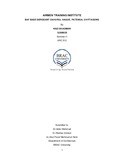| dc.contributor.advisor | Mahmud, Dr.Akter | |
| dc.contributor.advisor | Ahmed, Dr.Iftekhar | |
| dc.contributor.advisor | Nobi, Abul Fazal Mahmudun | |
| dc.contributor.author | Shadman, kazi | |
| dc.date.accessioned | 2019-03-21T07:21:08Z | |
| dc.date.available | 2019-03-21T07:21:08Z | |
| dc.date.copyright | 2018 | |
| dc.date.issued | 2018 | |
| dc.identifier.other | ID 12208025 | |
| dc.identifier.uri | http://hdl.handle.net/10361/11612 | |
| dc.description | This thesis is submitted in partial fulfillment of the requirements for the degree of Bachelor of Architecture, 2018. | en_US |
| dc.description | Cataloged from PDF version of thesis. | |
| dc.description | Includes bibliographical references (page 95-98). | |
| dc.description.abstract | Bangladesh Air Force is the ultimate aerial warfare branch of the country. Since the
force is the ultimate protector of the sky of the country, their training contains a lot
technical, physical and mental exercises and that is why the training institute must be
designed with such sensitivity. This training institute basically for the cadets/
students who will become ‘Airmen’ after completing their one-year training and
studies. Now, there is no ‘Training Institute’. The basic functions are scattered all
over the base. The proposal is to build an Institute to enhance the quality. The
existing training unit, which is scattered from the other wings of the institute, is
insufficient for modern Air defence training. The unit does not have swimming
complex, scientific Laboratory, indoor stadium etc. Computer science laboratory,
aero science laboratory and advanced air training is very important to achieve the
international quality of Airmen’s performance. On the hand the existing aircraft
hangars are not up to mark/ appropriate for keeping the aircrafts and helicopters as
well as insufficient for the airmen cadets to learn about Aircrafts. This institute must
be the best in the physical training and also should be good in the academic part of
the training. In this situation a state-of-art and sustainably working building is the
most desired. However, I studied the problem and get interviews of the Officer
Commanding, Project Commandant, several Airmen. I also get interviews from some
retired Airforce Officers and Airmen who were in charge of the unit and also trained
from there. The methods I follow are Interviewing the officer who are in charge of the
project and interviewing the cadets and new Airmen to find out their problem during
the training and what will help them. I did some questionnaire survey among the
officers and the airmen to get more appropriate demand of the project. This training
will give the Airmen many operational capabilities as well as train them to work with the civil aviation, DGFI (Directorate General of Forces Intelligence) and some civil
works of government offices. Airmen of our country have a huge contribution of the
Peacekeeping Missions of UN (United Nations) at Congo, Ivory Coast, Sudan and
help the country to earn a huge amount of Foreign Currency. | en_US |
| dc.description.statementofresponsibility | kazi Shadman | |
| dc.format.extent | 98 pages | |
| dc.language.iso | en | en_US |
| dc.publisher | BRAC University | en_US |
| dc.rights | BRAC University theses are protected by copyright. They may be viewed from this source for any purpose, but reproduction or distribution in any format is prohibited without written permission. | |
| dc.subject | Training institute | en_US |
| dc.subject | Bangladesh Air Force | en_US |
| dc.subject | Sergeant Zahurul Haque | en_US |
| dc.subject | Airman training | en_US |
| dc.subject.lcsh | Airmen--Bangladesh. | |
| dc.subject.lcsh | Training Institute. | |
| dc.subject.lcsh | Architecture--Bangladesh. | |
| dc.title | Airmen training institute BAF Base Sergeant Zahurul Haque, Patenga, Chittagong | en_US |
| dc.type | Thesis | en_US |
| dc.contributor.department | Department of Architecture, BRAC University | |
| dc.description.degree | B. Architecture | |

